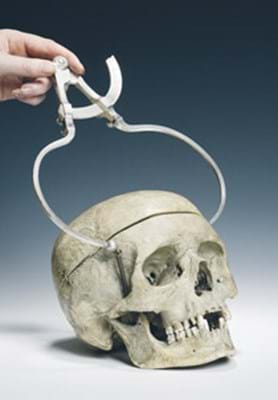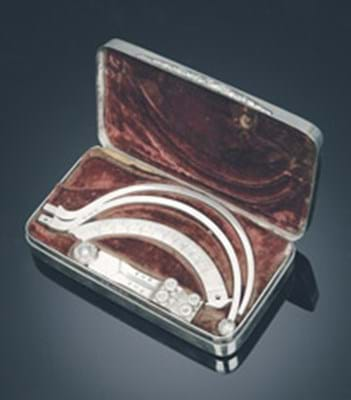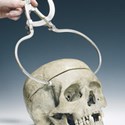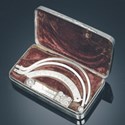The pseudo science of phrenology was based on the theories of the Viennese physician Franz Joseph Gall (1758-1828), whose central tenet held that the 'organs' or bumps in different areas of the skull provided an accurate index of talents and character. It first came into the public eye in the English-speaking world via a damning review in the prestigious Edinburgh Review of 1815. The phrenologists hit back and won many converts among the middle-class men of the New Town who took up "reading the bumps" as a scientific pursuit.
George Combe, an Edinburgh doctor and leading pioneer in the field, did much to popularise phrenology through his lectures and writings. His Constitution of Man sold an astonishing 350,000 copies, outselling Darwin's Origin of Species by seven to one.
The tool of his trade was the caliper used to take careful measurements of the shape and number of bumps on the skull. For example, a prominent protuberance in the forehead at the position attributed to the 'organ' of Benevolence and the individual could be expected to exhibit benevolent behaviour. A smaller bump and the character trait would be less pronounced.
Two pairs of Edinburgh-made silver calipers, presented to Combe by his students, were offered by Bonhams as part of their Scottish Sale of August 23-25 (the sale is reviewed in more detail in this week's Auction Reports and Art Market pages). They were consigned for sale alongside three pieces of presentation silver plus books from his library by descendants who are now resident in Northern Ireland.
The pair, pictured here both in use and in their rectangular velvet-lined silver case, carry the maker's mark IR, Edinburgh 1825. The case is inscribed to the cover: To George Combe Esqr. From Ladies Who Attended His Lectures On Phrenology in 1825 & 1826.
They sold for £2800 (estimate £500-1000) to a private collector (plus 17.5 per cent buyer's premium).
Proof that phrenology still had its adherents by the 1850s, a second pair with all-over chased scrolling foliage and set with four oval pastes carried the inscription: Presented To George Combe Esqr., By The Pupils Attending Mr. Williams' Secular School as a Testimonial of Their Respect & of Their Gratitude For His Exertions In Promoting Their Moral & Intellectual Improvement 26th January 1852. Marked for M. Crichton, Edinburgh 1852 this pair (minus their case) sold for £1700 (estimate £300-400) to an institution.
Phrenology may now be a forgotten 'science' but Combe's name is not. A department of psychology at Edinburgh University was funded by money from his estate and carries his name.
By Roland Arkell
The measure of an idea that was off its head
By the mid 19th century it had been completely discredited as a science, but between the 1820s and 1840s phrenology was at the peak of its popularity. And Edinburgh, where the first phrenological society was founded in 1820, was one of its centres.








